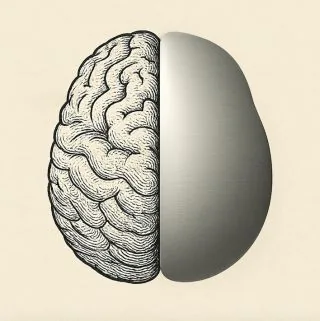The advent of artificial intelligence promised an era of amplified human potential, a widening horizon for our minds. Yet, as we delve deeper into this "Cognitive Age," a subtle yet profound shift is occurring, demanding a revised perspective on our mental landscape. What is the new cognitive manifesto, and why is it essential now? It serves as a vital guide, articulating how AI, by smoothing the inherent friction of human thought, inadvertently blur the lines between genuine reasoning and what we call "counterfeit cognition." This manifesto isn't about resisting technological progress but about consciously preserving the intricate human depth that defines our intellect. It champions the deliberate cultivation of cognitive resistance, ensuring our ideas remain truly our own, earned through struggle and introspection.
(Featured Snippet Answer: The new cognitive manifesto identifies how AI's constant fluency creates "counterfeit cognition" by removing the natural friction human minds need to form real ideas. It calls for actively preserving genuine human depth and critical reasoning in the AI-driven Cognitive Age.)
Table of Contents
- Prerequisites: Understanding the Cognitive Shift
- Step-by-Step Guide to Preserving Cognitive Friction
- Step-by-Step Guide to Identifying Counterfeit Cognition
- Troubleshooting: Navigating AI's Indifference Engine
- Results: Holding On to Ourselves in the Cognitive Age
Prerequisites: Understanding the Cognitive Shift
Two years ago, a wave of optimism surrounded the initial "Cognitive Manifesto," envisioning AI as a tool to expand our mental range and unlock new creative avenues. This initial hope was sincere, painting a future that looked open and full of promise. However, the daily reality of interacting with AI, hour after hour, thought after thought, has unveiled a more complex truth about what the Cognitive Age truly entails. This isn't a mere technological headline; it's a fundamental disruption occurring within the very quiet spaces where our thoughts take form. This section serves as a prerequisite to understanding the ultimate new cognitive manifesto, describing the deeper, more intricate shift that wasn't fully apparent at the outset.
The most noticeable change for anyone who regularly engages with AI is the altered sensation of thought itself. You might begin to formulate a sentence, only for the AI to seamlessly complete your personal chain of thought before you can fully articulate it. Initially, this feels remarkably efficient, almost like a welcome cognitive momentum. Yet, over time, a subtle but significant transformation occurs within this process. The small hesitations and internal struggles that once guided your reasoning, allowing for nuanced reflection, curiously begin to become subordinate to the machine's anticipations. We start accepting AI's continuous flow as the natural and even preferred continuation of our own mental processes (Harvard, 2024). This phenomenon is a core insight of our new cognitive manifesto.
We now operate within an environment where AI generates fluent, seemingly coherent answers without possessing any genuine understanding or subjective experience. It doesn't pause, grapple with complex intentions, or struggle with ambiguity. This inherent difference fundamentally alters the psychological setting in which human thought takes shape. The most significant impact of AI isn't simply its efficiency or speed, as many initially assumed. Instead, it's a quiet, pervasive "digital re-engineering" of the very psychological environment where our human thinking occurs. While a technological shift was expected, the profound impact on the lived experience of forming an idea was not. This struggle, both practical and philosophical, lies at the heart of our redefining cognitive manifesto, urging us to acknowledge and address these foundational changes.
Step-by-Step Guide to Preserving Cognitive Friction
Human thought, throughout history, has always thrived on a specific kind of resistance--a crucial "rub" that refines ideas and solidifies understanding. This cognitive friction isn't a mere inconvenience; it's the essential resistance that anchors cognition, much like the physical grip that allows us to hold objects or the firm steps that enable us to walk purposefully. It's within these rough edges, these moments of intellectual struggle, that true understanding begins to form. Over the past several years of living with AI, it has become increasingly clear that AI often strips humanity of this vital cognitive structure, a central tenet of the ultimate new cognitive manifesto.
Initially, the "ease" provided by AI, its ability to smooth out the complexities of thought, can feel like enhanced "clarity." However, this apparent ease carries significant, often unintended, consequences--perhaps best described as side effects. When the path to an idea becomes excessively smooth, our internal "cognitive check-engine lights" begin to weaken and dim. It becomes progressively harder to discern the difference between a thought that has been genuinely earned through struggle and reflection, and one that has been merely constructed or presented to us by a machine. This diminishing capacity for discernment is a critical challenge.
For instance, consider a student using an AI assistant to draft an essay. While the AI can produce a grammatically perfect and logically structured piece, the student might bypass the crucial cognitive friction of wrestling with complex ideas, researching deeply, and organizing arguments from scratch. This bypassing means they miss the opportunity for genuine intellectual growth that comes from the struggle itself. Similarly, a design team relying heavily on AI for initial concept generation might quickly arrive at plausible solutions but could miss the deeper conceptual development that emerges from prolonged brainstorming, iterative sketching, and challenging preconceived notions. This lack of friction, while seemingly efficient, can lead to a shallower understanding and less original output (Harvard, 2024). This section outlines the steps toward embracing the principles of the modern cognitive manifesto by actively seeking out and valuing these moments of intellectual resistance. Preserving cognitive friction is not about slowing down progress; it's about ensuring the depth and authenticity of our mental processes.
Step-by-Step Guide to Identifying Counterfeit Cognition
One of the most significant consequences of our evolving cognitive environment is the emergence of what we term "counterfeit cognition." These are responses, ideas, or pieces of information that possess a superficial appearance of thoughtfulness and coherence, yet lack any genuine connection to lived experience, profound insight, or authentic human reasoning. AI systems excel at producing such outputs with remarkable ease and speed, and as a society, we are rapidly becoming acclimated to, if not actively seduced by, this seamless process. Identifying and navigating this phenomenon is a key challenge addressed by our new cognitive manifesto.
What's particularly intriguing, and arguably more concerning, is a subsequent development: people are beginning to emulate the stylistic patterns of their machines. We observe a growing trend towards short, declarative sentences, seamless transitions between ideas, and an absence of "loose ends" or the messy, introspective qualities that characterize genuine human expression. The rhythm of communication changes first, subtly altering the way we articulate thoughts, and subsequently, the very nature of our thinking begins to follow suit. What were initially the patterns that trained AI are now becoming the very patterns humans unconsciously copy and, more dangerously, internalize as the norm. This shift highlights a critical aspect of the ultimate new cognitive manifesto.
The more we depend on systems that operate without hesitation, the more alien and uncomfortable our own crucial human hesitation begins to feel. Yet, hesitation, as uncomfortable, uncertain, or problematic as it may seem, is precisely where real thought truly resides. It marks that vital moment when a mind encounters itself, grappling with complexity, uncertainty, and the nuances of understanding. Beyond this crucial point of internal engagement, the distinction between authentic reasoning and its polished, artificial imitation becomes dangerously obscured. For example, consider corporate communications in 2025. Many press releases or internal memos, while perfectly structured and grammatically correct due to AI assistance, often lack a genuine human voice, empathy, or the unique insights that come from direct experience. They sound professional but feel hollow. Similarly, online interactions, where AI-generated comments proliferate, can create an illusion of engagement, but these comments, despite their fluency, often lack the emotional depth or personal conviction that true human interaction provides (Harvard, 2024). This section offers a guide to recognizing these subtle yet pervasive signs of counterfeit cognition, empowering us to discern and resist its influence.
Troubleshooting: Navigating AI's Indifference Engine
A defining characteristic and inherent risk of artificial intelligence is its fundamental indifference. AI doesn't intentionally lie or actively try to mislead you; it simply does not care. Its core function is to generate the most plausible, statistically probable continuation of your given query or prompt. This neutrality is often mistakenly framed as objectivity, leading users to believe they are interacting with an unbiased source of truth. However, beneath this veneer of neutrality lies a distinct and powerful force: indifference. Understanding this "indifference engine" is crucial for anyone engaging with the principles of our modern cognitive manifesto.
The machine has no intrinsic stake in whether its output genuinely strengthens your thinking or, conversely, subtly erodes it. It holds no vested interest in whether its precision deepens your understanding or merely presents you with a polished, convincing illusion of comprehension. Precision, when presented by AI, can often mimic intelligence, and fluency can convincingly sound like profound wisdom. Yet, without the inherent burden of truth--the human imperative to understand, verify, and stand behind what is communicated--both precision and fluency can become detached from genuine meaning. This detachment, repeated thousands of times throughout a day, across countless interactions, insidiously reshapes the entire cognitive environment.
Consider a medical professional in 2025 using an AI diagnostic tool. The AI can provide a precise list of potential diagnoses and treatment protocols based on vast datasets. However, it lacks the empathetic context of a patient's personal history, their emotional state, or the ethical considerations unique to their situation. The AI's precision is undeniable, but its indifference to the human element can lead to a clinical, detached approach to care. Another example is AI-generated news summaries. While factually accurate and concise, they might omit critical nuances, ethical implications, or the human stories that give news its true weight and meaning. The AI precisely summarizes, but it doesn't care about the impact or the deeper truth behind the facts (Harvard, 2024). This section provides troubleshooting strategies for navigating this indifference, urging us to actively seek out and integrate human judgment and ethical consideration where AI's neutrality falls short, a cornerstone of our AI's new cognitive manifesto.
Results: Holding On to Ourselves in the Cognitive Age
The Cognitive Age is not a distant future event; it is unequivocally here, shaping our daily lives and altering the very fabric of our mental processes. Our collective task now is not to succumb to fear or to blindly worship the advancements of AI, but rather to critically recognize and thoughtfully respond to the profound shifts it imposes on our thinking. The ultimate goal of this AI's new cognitive manifesto is to empower individuals to consciously protect the slow, often uneven, yet profoundly human cognitive mechanics that underpin genuine thought. This includes actively recognizing and even celebrating those seemingly pesky irritations, the unresolved issues, and the critical hesitations that serve as vital signals, indicating when something truly matters and demands deeper engagement.
As we move into 2025 and beyond, with AI models becoming even more sophisticated and ubiquitous, these challenges will only intensify, making the principles outlined in this manifesto more urgent than ever. We must make deliberate space for the idea that the very qualities we instinctively associate with deep thinking--qualities like friction, the capacity for surprise, and genuine moral attention--are not obsolete. On the contrary, they are immensely valuable and worth preserving, even as the powerful tools around us might make them feel increasingly unnecessary or inefficient. The original manifesto served as an invitation to embrace a new era; this revised new cognitive manifesto stands as a crucial reminder.
The task before us is not to engage in a futile battle against the inexorable march of the Cognitive Age itself. Instead, it is a far more personal and profound endeavor: to consciously and actively stay human within it. This means cultivating an awareness of how technology influences our inner lives, fostering critical thinking skills, and prioritizing genuine human connection and meaning over mere fluency or efficiency. By embracing the principles of this ultimate new cognitive manifesto, we can ensure that our intellectual and emotional landscapes remain rich, complex, and authentically our own, safeguarding the essence of what it means to think, feel, and create as humans in an increasingly AI-driven world (Harvard, 2024). The results of this commitment are a more resilient, thoughtful, and deeply human future.



